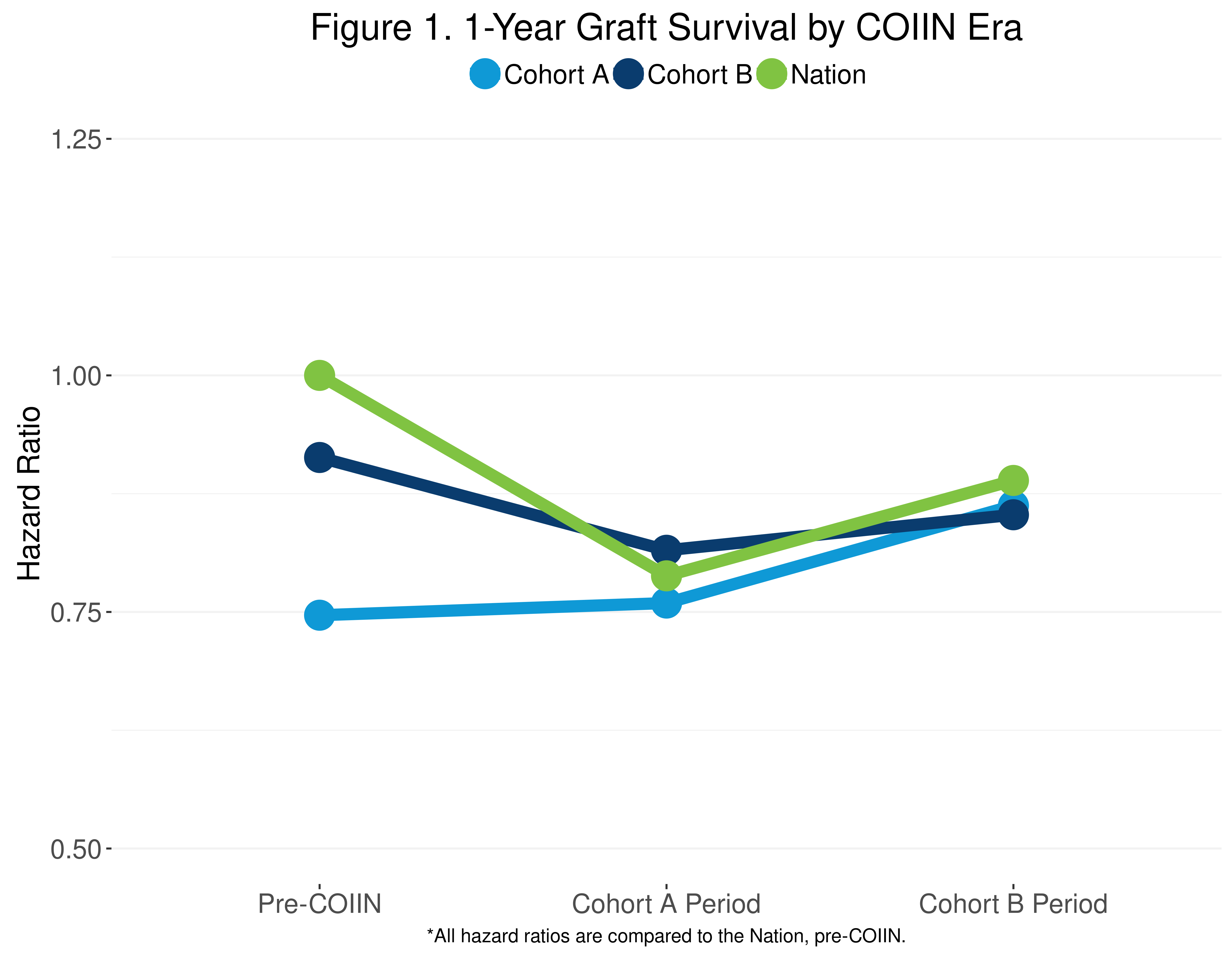One Year of COIIN Outcomes: Did Cohorts A and B Maintain Graft Survival?
United Network for Organ Sharing, Richmond, VA
Meeting: 2020 American Transplant Congress
Abstract number: 117
Keywords: Graft failure, Graft survival, Kidney
Session Information
Session Name: Kidney Deceased Donor Selection I
Session Type: Oral Abstract Session
Date: Saturday, May 30, 2020
Session Time: 3:15pm-4:45pm
 Presentation Time: 3:15pm-3:27pm
Presentation Time: 3:15pm-3:27pm
Location: Virtual
*Purpose: The Collaborative Innovation and Improvement Network (COIIN) was a 3-year OPTN project aimed at increasing the utilization of kidneys with a kidney donor profile index (KDPI) greater than 50%. Using a collaborative framework, overall, 15 out of the 19 Cohort A centers and 22 out of the 39 Cohort B centers successfully transplanted a higher volume of KDPI 51-100% kidneys during the 9 month COIIN period compared to the same time period a year prior. To determine if this change had an effect on post-transplant graft survival, this abstract looks at the overall 1-year graft survival for transplant centers in Cohorts A and B compared to non-COIIN centers (the Nation).
*Methods: A Cox Proportional-Hazards model was fit using OPTN data to assess 1-year post-transplant graft survival. Analysis was restricted to adult, kidney-alone deceased donor transplants that took place pre-COIIN (1/1/2016-12/31/2016), during the Cohort A period (1/1/2017-9/30/2017), and during the Cohort B period (10/1/2017-6/30/2018) (n = 31,224). The model adjusted for KDPI, as well as other covariates used in the SRTR Kidney Risk Adjustment Models. Hazard ratios (HR) and 95% confidence intervals (CI) for each cohort across each COIIN era are reported. Hazard ratios less than 1 indicate increased risk of graft survival.
*Results: Pre-COIIN, the overall 1-year graft survival hazard ratio for Cohort A was significantly lower compared to the Nation (HR: 0.75, CI: 0.57, 0.97) (Figure 1). The overall hazard ratio for Cohort A remained similar during the Cohort A intervention period compared to the Nation pre-COIIN (HR: 0.76, CI: 0.58, 1.00) and increased during the Cohort B intervention period (HR: 0.86, CI: 0.66, 1.12). The overall hazard ratio for Cohort B decreased during the Cohort A period compared to the Nation pre-COIIN (HR: 0.82, CI: 0.67, 1.00) and remained similar during the Cohort B period (HR: 0.85, CI: 0.70, 1.04). Similarly, the overall hazard ratio for the Nation decreased during the Cohort A period compared to pre-COIIN (HR: 0.79, CI: 0.68, 0.92) and increased slightly during the Cohort B period (HR: 0.89, CI: 0.77, 1.03).
*Conclusions: While participating in the COIIN collaborative framework, COIIN centers performed an increased number and proportion of higher KDPI transplants while maintaining a similar risk of 1-year graft survival. These results suggest that in the context of collaborative improvement efforts, moderate to high KDPI kidneys can be transplanted without increasing the risk of adverse graft survival outcomes.
To cite this abstract in AMA style:
Foutz J, Carrico RJ, Sisaithong K, Tosoc-Haskell H, Klassen D. One Year of COIIN Outcomes: Did Cohorts A and B Maintain Graft Survival? [abstract]. Am J Transplant. 2020; 20 (suppl 3). https://atcmeetingabstracts.com/abstract/one-year-of-coiin-outcomes-did-cohorts-a-and-b-maintain-graft-survival/. Accessed November 26, 2025.« Back to 2020 American Transplant Congress

